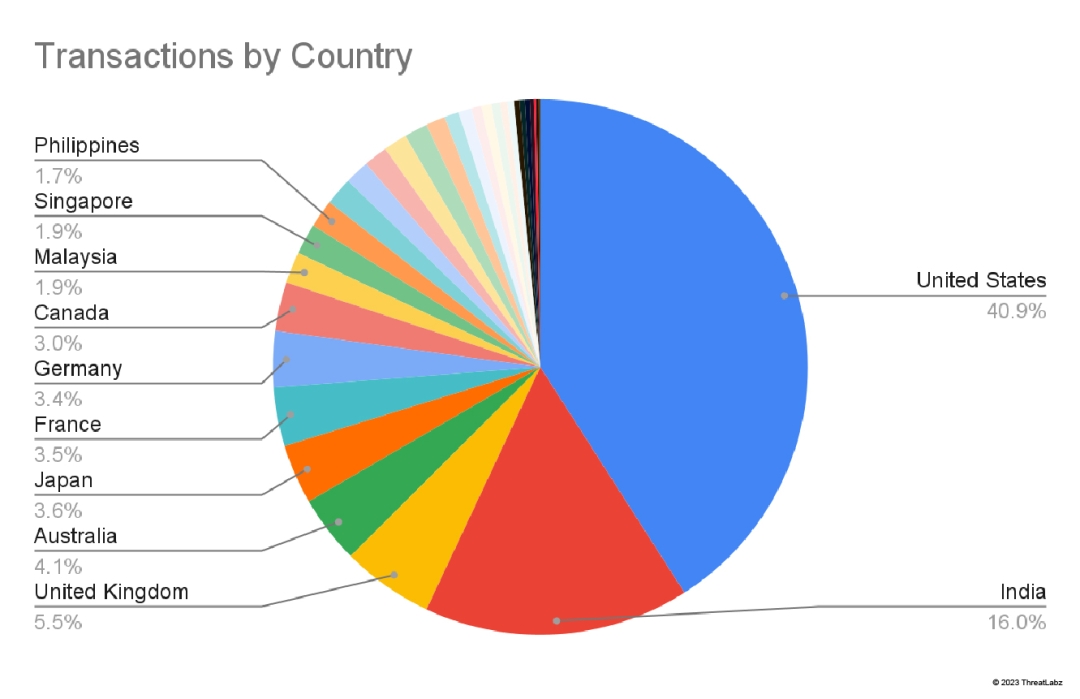Zscaler Blog
Get the latest Zscaler blog updates in your inbox
Subscribe
Analysis of Generative AI Trends and ChatGPT Usage
Introduction
The release of ChatGPT underscores the potential of artificial intelligence to revolutionize the daily operations of organizations. This paradigm shift is compelling businesses to reevaluate their conventional approaches and embrace the transformative capabilities offered by AI. Among the noteworthy facets of AI’s evolution, Large Language Models (LLMs) have emerged as a dominant force, reshaping user interactions and communication. The driving force behind this transformation is the pursuit of vast datasets, enabling machine learning algorithms to analyze patterns and generate responses in a seamlessly natural language.
In this blog, we aim to provide a comprehensive perspective on the impact of AI-powered applications and offer guidelines for the responsible integration of AI tools within organizational contexts.
Key Takeaways
- OpenAI.com stands out as the preeminent domain for AI and ML enthusiasts, offering a wealth of resources, research, and interactive AI models. Notably, over half of the website’s traffic is attributed to ChatGPT, underlining its significant impact on user engagement and AI exploration.
- Drift has secured its position as the most popular AI/ML application, specifically excelling in language processing through LLM-based SaaS solutions. Drift’s popularity rivals ChatGPT, which came in just under Drift by less than 1%.
- ChatGPT experienced a substantial surge in usage during the initial months of this year, indicative of its growing relevance and adoption. However, the upward trajectory reached a plateau in August.
- The lion’s share of AI/ML traffic is predominantly generated from the United States and India. The primary use case for this global traffic surge is the exploration and implementation of generative AI applications.
AI vs LLMs
AI and LLMs are two interconnected but distinct concepts in the field of computer science. AI represents the broader umbrella term, encompassing a wide array of techniques and technologies designed to simulate human intelligence and problem-solving. It includes machine learning, generative artificial intelligence models, natural language processing, computer vision, robotics, and deep learning, among others. LLMs are a specific subset of AI, focused primarily on natural language understanding and processing.1
How ChatGPT, and similar generative AI modules like GPT-3 and GPT-4, operate within the realm of AI applications has garnered significant attention in recent years. While AI has been in development for decades and encompasses a diverse range of technologies, LLMs have gained prominence relatively recently due to their remarkable ability to generate human-like text.2
AI/ML Usage Trends
AI Usage Soars Then Stabilizes
From April to June of this year, we observed a consistent upward trajectory in AI/ML usage and traffic. However, since August, there has been a gradual decline in activity since then, reflecting the dynamic nature of AI trends.
 Figure 1: A graph illustrating the sharp rise of AI traffic and sudden stabilization.
Figure 1: A graph illustrating the sharp rise of AI traffic and sudden stabilization.
AI’s Transformation of Manufacturing
The manufacturing industry emerged as a key driver of AI/ML traffic, offering a compelling glimpse into the rapid advancements made during the Industry 4.0 era3. This sector’s engagement highlights the pivotal role of AI and ML in shaping the future of manufacturing. Besides manufacturing, the following industry verticals stood out:
- Finance
- Technology
- Services
 Figure 2: A breakdown of the top AI/ML traffic producers by industry.
Figure 2: A breakdown of the top AI/ML traffic producers by industry.
As evident from the data presented, a significant portion of the observed transactions originates from the manufacturing sector, predominantly featuring applications like ChatGPT, Drift, and Pypestream. Simultaneously, the finance sector holds a substantial share, accounting for 17.2% of the transactions, driven primarily by the adoption of ChatGPT and Drift. Irrespective of the industry vertical, ChatGPT, Drift, and LivePerson emerge at the frontrunners in terms of popularity among generative AI-powered applications. Drift is an AI powered conversational tool that integrates with email and chat. While LivePerson is also an AI powered service for customer interaction.
 Figure 3: A graph showing usage over time by industry.
Figure 3: A graph showing usage over time by industry.
ChatGPT, Driving Force Behind OpenAI.com Popularity
Unsurprisingly, OpenAI.com emerged as the dominant player, accounting for a substantial share of our observed transactions, approximately 36% in total. Interestingly, within this substantial figure, a noteworthy 58% can be attributed to ChatGPT-related traffic. This data indicates the important role of OpenAI.com in facilitating a significant portion of our transactions, with ChatGPT serving as a key driver of engagement and activity on the platform. After OpenAI.com, the top domains are:
- drift.com
- ada.support
- Quillbot.com

Figure 4: A breakdown of the top AI/ML-related domains.
Drift Takes Lead in Language Processing
The foremost AI/ML language processing application in use is Drift, leading the pack, with ChatGPT and LivePerson closely following suit. A significant focus among users revolves around language processing tools employing LLMs. The overarching goal centers on enhancing automated user interactions, as evidenced by widespread adoption in chatbot integration, in-hour writing tool utilization, and speech-to-text applications.
 Figure 5: A breakdown of the most popular language processing AI applications.
Figure 5: A breakdown of the most popular language processing AI applications.
ChatGPT Usage Trends
ChatGPT Usage Sharply Rises Then Plateaus
Our analysis reveals a notable pattern in ChatGPT usage. From May to June, we observed a sharp and noteworthy surge in ChatGPT-related transactions, followed by gradual ascent that extended until August. However, it is in this month that we witnessed a leveling off, marking a plateau in its usage, mirroring the broader trends evident in overall transaction patterns within the AI/ML traffic landscape.
 Figure 6: A graph showing the increase and then plateau of ChatGPT usage.
Figure 6: A graph showing the increase and then plateau of ChatGPT usage.
ChatGPT’s Impact Across Top Verticals
ChatGPT finds its most significant application and impact across a spectrum of key verticals, including manufacturing, finance, services, technology, and the energy sector. These diverse industries have integrated ChatGPT to enhance their operations, decision-making, and customer interactions.
 Figure 7: A breakdown of the top ChatGPT users by industry.
Figure 7: A breakdown of the top ChatGPT users by industry.
Mirroring the broader AI/ML transaction trend, we observed a steep rise from May to June, followed by a sustained level of activity until August. However, it’s worth noting that while transactions related to AI/ML show a decline across various verticals, the finance sector stands out with a continuous rise since June.
 Figure 8: A graph depicting the rise and stabilization of ChatGPT in various sectors, except for finance - where ChatGPT has grown since June.
Figure 8: A graph depicting the rise and stabilization of ChatGPT in various sectors, except for finance - where ChatGPT has grown since June.
Trends by Location
The primary sources of traffic come from the United States, India, and the United Kingdom where ChatGPT, Drift, and LivePerson emerge as the top AI applications in use. This observation strongly reinforces our suggestion that, regardless of industry or national borders, language processing remains the foremost use case for generative AI applications. Across diverse verticals and geographies, the transformative impact of AI-powered language processing continues to shape AI adoption and innovation.
 Figure 9: A breakdown of the countries that generate most of the AI/ML-related traffic.
Figure 9: A breakdown of the countries that generate most of the AI/ML-related traffic.
Securing AI/ML Transactions
Significantly, the majority of AI/ML-related transactions undergo thorough scrutiny so 10% of all AI/ML-related transactions are blocked using URL filtering policies. The technology sector takes the lead in blocking AI/ML transactions, closely followed by the finance and manufacturing sectors.
 Figure 10: A breakdown of which industries are blocking the most AI/ML-related transactions.
Figure 10: A breakdown of which industries are blocking the most AI/ML-related transactions.
Drift holds the unique distinction of being both the most used and most frequently blocked application.
 Figure 11: A pie chart showing how the overwhelming majority of blocked AI/ML transactions originate from Drift - a conversational AI application.
Figure 11: A pie chart showing how the overwhelming majority of blocked AI/ML transactions originate from Drift - a conversational AI application.
AI/ML Best Practices Guide
Considering the rapid advancement and adoption of AI-powered applications, it is crucial to establish and follow best practices to ensure the responsible and secure use of these transformative technologies.
- Organizations must proactively adapt their AI usage and security policies to stay ahead of potential risks and challenges.
- Recognize that AI-powered applications come with risk and continually assess and mitigate risks to protect intellectual property, personal data, and customer information.
- Ensure that the use of AI tools complies with all relevant laws and ethical standards. This includes data protection regulations and privacy laws.
- Establish clear accountability for the development and deployment of AI tools. Define roles and responsibilities within your organization to oversee AI projects.
- Maintain transparency when using AI tools, Justify their use and communicate their purpose clearly to stakeholders.
Guidelines
- Do not provide non-public information, personally identifiable information (PII), proprietary company data, or any confidential information to AI models.
- AI cannot replace a human being. It should not be used to make decisions without appropriate human intervention.
- AI-generated content should not be used without human review and approval, especially in cases where the content represents your organization.
- The development and integration of AI tools should follow a Secure Product Lifecycle Framework to guarantee the highest level of security.
- Perform thorough product due diligence before implementing AI solutions. Make sure to evaluate their security and ethical implications.
Conclusion
From the release of ChatGPT and the prominence of AI-powered applications like Drift, to the pivotal role of LLMs and the services hosted on OpenAI.com, we’re witnessing a dynamic AI revolution. The global interest, particularly from the United States and India, in generative AI applications highlights the transformative possibilities these technologies bring. As exciting as these changes are, it’s important to incorporate best practices and guidelines into your AI/ML strategy to ensure the responsible and ethical use of such AI-powered applications. As the technological landscape continues to shift, it’s essential to remain vigilant, responsible, and adaptive as we utilize AI/ML to shape the future. Zscaler's ThreatLabz team continuously monitors for new threats and shares its findings with the wider community.
1 https://cset.georgetown.edu/article/what-are-generative-ai-large-language-models-and-foundation-models/
2 https://www.businessinsider.com/everything-you-need-to-know-about-chat-gpt-2023-1
3 https://www.mckinsey.com/featured-insights/mckinsey-explainers/what-are-industry-4-0-the-fourth-industrial-revolution-and-4ir
Was this post useful?
Get the latest Zscaler blog updates in your inbox
By submitting the form, you are agreeing to our privacy policy.


